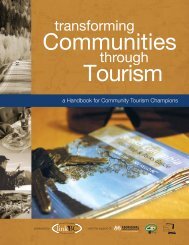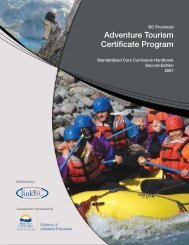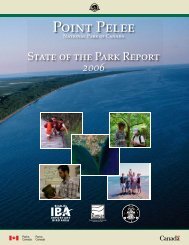Cultural Heritage Tourism Handbook - LinkBC
Cultural Heritage Tourism Handbook - LinkBC
Cultural Heritage Tourism Handbook - LinkBC
- No tags were found...
Create successful ePaper yourself
Turn your PDF publications into a flip-book with our unique Google optimized e-Paper software.
Saskatchewan ShowcaseA Goal Emerges; Steps are TakenIn 2006 a small group of tourism developers and historicsite managers gathered in Saskatoon to discuss how theselocations, and the stories they tell, could be brought together,invigorated, and collectively attract more visitors to theregion. They chose a target for completing the first phase1. Sites and historic locations were mappedand assessed, and an inventory of all possible1885-related attractions in region was undertaken.2. An initial meeting was held with stakeholders todetermine their appetite for hosting visitors, andtelling their stories in their own words.3. Stakeholders became aware of, and started toaccept, different interpretations and points of viewabout the events of 1885. It was noted, however,that First Nations stories had been missed in previousinitiatives.4. The group decided that other than the basic connectionto the North West Resistance, there wouldbe no common script.5. A range of additional stakeholders were added towhat became known the 1885 Coalition: provincialtourism organizations; federal, provincial, municipal,and community attractions; community museums;tour operators; accommodations; and First Nationsand Métis Elders.Trails of 1885Bridges Cultures &Attracts <strong>Tourism</strong>Historic Confrontations Set the StageFor years, Saskatchewan residents have fostered a rangeof sites known for the dramatic events and intensepersonalities of the North West Resistance (formerlycalled the North West Rebellion) of 1885. These locationsrange from battle sites with major interpretive centresto remote meadows and hillsides where solitary historicmarkers recount stories from an almost mythical past.of these tasks: the 125th Anniversary of the North WestResistance (in 2010). Ian McGilp from <strong>Tourism</strong> Saskatchewanshared the following summary of some of the many stepsthey took:6. The group extended to Albertan sites involved inthe Resistance, and to Manitoba, where the story ofLouis Riel was already marketed to attract visitors.7. They chose a Coalition project manager from oneof the province’s regional tourism marketing organizationsfamiliar with many of the sites.8. In 2008, approvals were obtained from federal, provincial,and municipal departments, and <strong>Tourism</strong>Saskatchewan for a cost-shared three-year project.9. An Advisory Committee was formed of projectfunders, site administrators, tourism developers,First Nations <strong>Cultural</strong> College, Gabriel DumontInstitute, and other stakeholders.10. The committee ‘opened doors’ for the ProjectManager among Coalition members, differentagencies, ministries, First Nations, Municipalities,and the Métis Nation of Saskatchewan.11. <strong>Cultural</strong> requirements and sensitivities, language ofdelivery, interpretation and visuals were assessed.12. A Trails of 1885 brand was developed, through significantrelationship building by the project manager with individualFirst Nations and the Métis Nation.13. In 2009 a website was established as a prelude to manyactivities planned for the 125th anniversary year.14. The formal Year of the Métis and 125 th Anniversary waslaunched with a major ceremony attended by dignitaries,dancers, drummers, fiddlers, actors, and Elders from Albertaand Saskatchewan. A huge elk hide proclamation wassigned by the Federal and Provincial governments, FirstNations, and Métis Nation acknowledging the significanceof 1885 to the future of Canada.The opening of the 125th anniversary celebrations was truly only thebeginning. Major events were held throughout the year including thefirst-ever re-enactment of the Battle of Poundmaker Cree Nation; and1885 ceremonies at the Marr (Field Hospital) Residence in Saskatoon,Fort Battleford, Fort Carlton, Fort Pitt, Steele Narrows, and Humboldt.The addition of Trails of 1885 resulted in the largest ever attendanceat the annual Métis homecoming festival ”Back to Batoche Days”.To support long-term tourism benefits to the region, events werereinforced by capital projects such as highway improvements,highway signage, site signage, large maps at 1885 sites, multimilliondollar improvements at Batoche NHP, major improvementsto the Duck Lake Regional Interpretive Centre, rededication ofTourond’s Coulee/Fish Creek NHS, major infrastructure work at FortPitt, ‘Wounded Warrior’s Park’ designation in Prince Albert, and others.Promotion CriticalPromotional and other activities included the extensively distributedTrails of 1885 Travel Guide, the well-received 1885 website, mintageof a commemorative medallion, an essay-writing contest in schools,major daily radio spots from May through early September, powwows, performances of “The Trial of Louis Riel”, and more.Three self-guided itineraries through the 1885 product clusters weredeveloped: Valleys of the Saskatchewan, Battle River Country, andthe North West Frontier, and a geo-caching project involving ten1885 sites was launched.Governance Adapts as Situation ChangesIn 2011, the regional tourism association was discontinued andmarketing responsibilities for its broad base of industry memberswere assumed by <strong>Tourism</strong> Saskatchewan. A new non-profit corporation“Trails of 1885 Association, Inc.” was created. Its Board of Directorsis currently in the process of developing priorities and a businessplan to build on the momentum and successes of the last 5 yearsand take the 1885 project forward into the future.Lessons LearnedFind out more: www.trailsof1885.com”The main lessons learned have been around the importance ofcommunication and respect,” says McGilp. “The project saw theclosest participation of First Nations, Métis Nation, and tourisminterests in the commemoration of a series of major historicevents that I can recall,” a tribute to the dedication of projectmanager Colleen Norrish. “Keeping the stakeholders up to dateon what is going and answering questions before they becomeissues has been vital.”He concludes, “The project has certainly met one of its main goals –tostrive to increase visitation, and visitor satisfaction while developingcultural awareness locally, regionally, provincially, and nationally.”66 67










